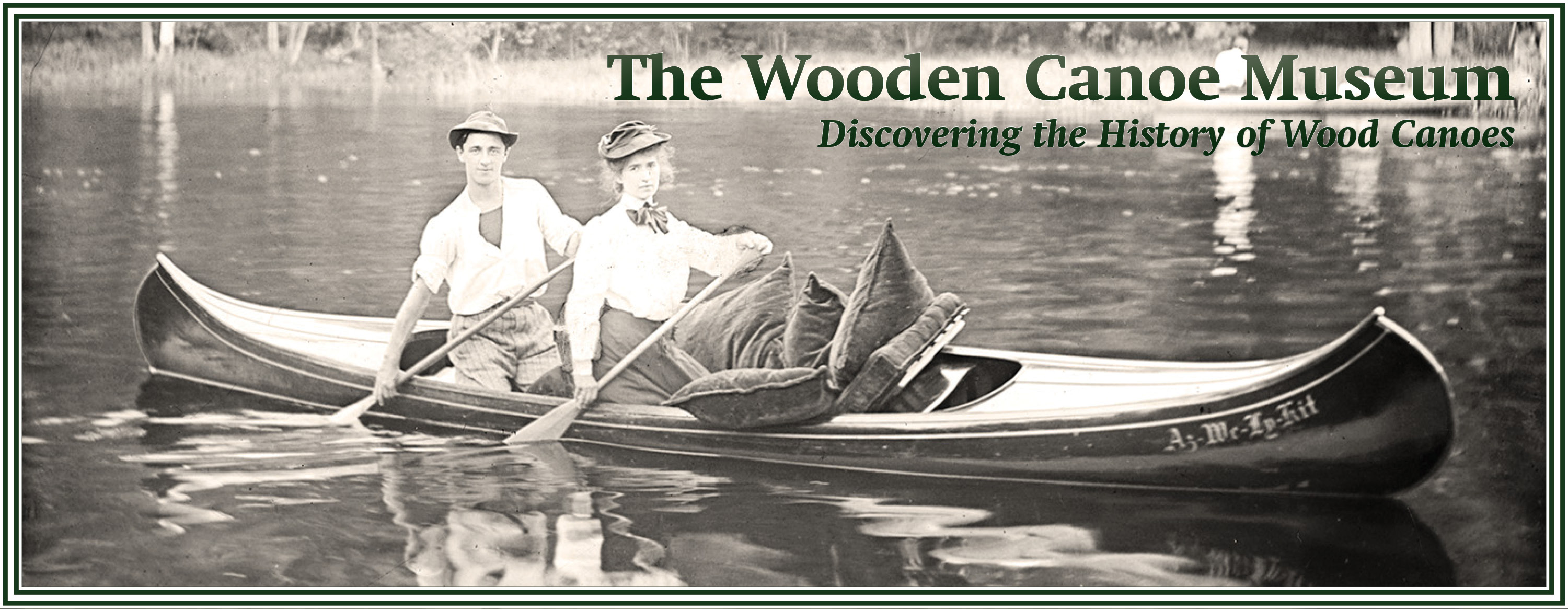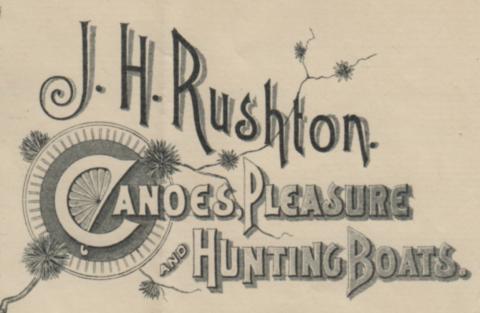J. H. Rushton, Inc.
J. W. Rushton
J.H. (John Henry) Rushton began building boats in 1875 in Canton, New York. He quickly became well known for his Rob Roy-style decked canoes and pulling boats. He built the original Vesper decked sailing canoe for Robert Gibson who went on to win the first American Canoe Association International Challenge cup.
Rushton offered a wide range of all-wood paddling and sailing canoes, including the well known Ugo and Arkansaw Traveler models. He was instrumental in kicking off the popularity of small double-paddle canoes by building a series of these for Nessmuk (George Washington Sears), who would write about his travels in them in Forest and Stream.
Rushton was relatively late in adapting to the canvas canoe market, the origins of which date to around 1886-87. His canvas covered Indian model, which he also offered in an all-wood version, was first offered in 1901, and in 1902 the Indian Girl model was offered.
Rushton died in 1906. His widow and son incorporated the business and remained in operation until 1917. Canoes and boats built between 1906 and 1917 can usually be identified by the presence of a "J.H. Rushton, Inc." brand or tag.
Rushton All-Wood Canoes
- American Traveling Canoe and other Rob Roy derivatives
- Hunting Canoes
- Ugo,Igo, Arkansaw Traveler
- Decked Sailing Canoes
Rushton Canvas-Covered Canoes
Rushton entered into the canvas canoe market in 1901 when he introduced his 15' Indian model, which was available in both all-wood and canvas-covered versions. By 1902, he had designed the Indian Girl model, which became one of his best selling canoes. Construction of canvas canoes was contracted to Melvin Roundy, who had come to Canton from Bangor, Maine via Ogdensburg, New York. As Bangor is only five miles from Veazie, Maine, where the B.N. Morris Canoe Company was located, he may have had some influence over the design of the Indian Girl, as there are many similarities with Morris canoes.
Following Rushton's death in 1906, Roundy left Canton, and canvas canoe production was contracted to Frank Fox. Fox and his crew, which usually numbered three or four builders, built about 200 canoes per year in the nineteen-teens.
While no records are known to survive for Rushton's canvas covered canoes, the canoes were marked with serial numbers, and the numbers on surviving canoes suggest about 5500 canoes were built before the factory closed.
Sometime after the Rushton factory closed in 1917, Joseph Leyere, a noted boat builder from Ogdensburg, New York, acquired the Indian Girl molds and the rights to build them. He marketed these under the "Whistle Wing" trademark of the St. Lawrence Boat Works until sometime in the late 1920s.
- Indian Girl - Introduced in 1902 and always Rushton's best selling canvas canoe, the Indian Girl was available in lengths from 15' to 18'. Offered in Grade A (two piece gunwales and pocketed ribs) and Grade B (heavier inwales and thin outside rails and rail caps). In 1915, a Deluxe grade (with mahogany trim and cherry outside stems) was introduced, and in 1916, 5 different grades were offered. Highlights of Rushton's Indian Girl model are shown in this video.
- American Beauty - Introduced by 1904, the American Beauty was a high grade Indian Girl built with top grade materials and extra long decks, usually of figured maple.
- Navahoe - The Navahoe model was similar to a B grade Indian Girl, but with spruce rails, decks, seats and thwarts. The sheer was also altered to facilitate easy construction. The Navahoe was only available in 16' lengths.
- Indian - introduced in 1901, the Indian was Rushton's first foray into the canvas canoe market. It was built in both canvas-covered and smoothskin lapstrake construction, and only available in 15' lengths.
- Big Chief - offered in the 1904 catalog in larger sizes, ranging from 18' to 21'. One 20' example is known. Heavily built, it has a Rushton, Inc. medallion and was not given a serial number.
- Bond, Hallie E. 1995. Boats and Boating in the Adirondacks. The Adirondack Museum/Syracuse University Press.
- Brenan. Dan, editor. 1993. Canoeing the Adirondacks with Nessmuk: The Adirondack Letters of George Washington Sears. The Adirondack Museum/ Syracuse University Press.
- Crowley, William. 1983. Rushton’s Rowboats and Canoes: The 1903 Catalog in Perspective. The Adirondack Museum/International Marine. Available from the WCHA Online Store
- Manley, Atwood. 1968. Rushton and His Times in American Canoeing. The Adirondack Museum/Syracuse University Press.
- Miller, Daniel. 2011. Poems in Cedar: Rushton Canoes of the Finest Kind (Part 1) Wooden Canoe 167:5-14 and (Part 2) Wooden Canoe 168:8-16
- Miller, Daniel. 2011. The Rushton Mystique. Wooden Canoe 163:10-12
- Miller, Daniel and Benson Gray. The Historic Wood Canoe and Boat Catalog Collection, Version 2. This digital collection of catalogs includes 9 Rushton catalogs. Available from the WCHA Online Store.
- Rushton, J.H. Catalogue: Canoes, Pleasure and Hunting Boats. 1893 (Reprint). Available from the WCHA Online Store
- Rushton, J.H. Rushton’s Portable Sporting Boats. 1889 (reprint 2002). The Boat House. Portland, Oregon. 2002

